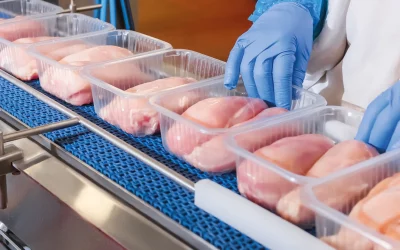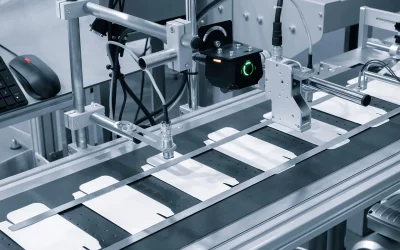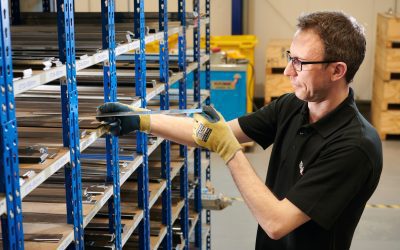The essential properties of meat processing and packaging knives
Before we delve into the nuances of meat processing and packaging knives we’re going to cover the fundamental properties blades should possess.
No matter what application a knife or blade will be put to, it should possess the following characteristics.
Quality manufacture
Meat processing knives have to withstand a considerable amount of punishment whilst retaining their cutting ability. So, it’s essential that you choose blades which have been manufactured by a company with demonstrated expertise and experience in the production of industrial knives and blades.
Quality material
The blade, regardless of its intended application, should be manufactured from a suitable material.
Meat processing and packaging knives are typically made from stainless steel 420 or 440 – yet, it’s vital that this steel is of a high-enough hardness to withstand prolonged use and provide many cycles of unimpeded cutting performance.
Your processing knives will, in some instances, need to slice firm muscle and tendons, and as such need to have the strength and integrity to make repeated, clean, aesthetically-pleasing cuts.
Quality coatings
Depending on the type of meat you’ll be processing, and the jurisdictions within which you’ll be carrying out the work, you may need to ensure that your meat processing knives and blades feature appropriate coatings.
These coatings can range from Teflon to TiN (and multiple other finishes in between). Make sure you choose a blade manufacturer that’s able to provide your required finishes.
Ease of maintenance
Due to the necessarily high levels of health, safety and hygiene regulations associated with meat processing, it’s important that blades and knives are easy to remove, clean and generally be kept in top condition.
As such, it’s important that you work with a knife and blade supplier that’s able to manufacture blades that are suitable for your particular processing machines. You need blades and knives which can be easily removed and reinstalled without causing excessive downtime for your processing operations.
What can industrial meat processing and packaging knives be used for?
Good quality processing and packaging knives can be used for a wide variety of different individual processes. Production knives and blades can be used for deboning, portioning, slicing, marinating, tumbling, dicing, cubing, and many other cutting tasks.
Packaging knives and blades are typically used for trimming and cutting excess material from finished packages. For example, industrial vacuum packing machines will use food packaging knives to remove material from around the edges of a package once packaging is complete.
What types of industrial meat processing and packaging knives are there?
There are many different types of industrial meat processing and packaging knives on the market. Each of which serves a distinct purpose within the meat processing cycle.
Below we’ve listed some of the most common types of meat processing and packaging knives (all of which are available from MRMK).
Bandsaw blades
Bandsaw blades are designed to cut through all types of meat including that with bones, with minimal wastage. They are typically used for large cuts and can be used in high-volume processing environments.
The very best bandsaw blades will consistently provide a clean, accurate and visually-appealing cut.
Bone processing blades
As their name suggests, bone processing blades are used for cutting through bones within the meat.
Good-quality bone processing blades, such as those manufactured by MRMK, are approved for food contact worldwide and will remain rust-free, meaning they’ll provide thousands of cycles of faultless service.
Bowl choppers/cutters
Bowl choppers (also sometimes referred to as cutters or mixers) are used in conjunction with a large bowl in order to cut up and process meat products.
With many bowl cutters, a stainless-steel bowl will rotate round whilst a knife head spins vertically, chopping and cutting meat up against the inside surface of the bowl.
Good quality bowl choppers will be manufactured from top-grade, food-safe stainless steel and will be mirror polished in order to reduce the build-up of rust, thereby providing a longer service life.
Circular slicers
Circular slicers are razor-sharp, circular blades that are designed to make the cutting and processing of meat as efficiently as possible.
Circular slicers are normally available in multiple different finishes (such as hard chromed, high polished, or Teflon), are manufactured from food-safe stainless steel, and can be customised to fit any processing machine.
Cutoff blades
Designed to be used in combination with dicer or grid blades, cutoff blades are predominantly used for cutting or dicing meats.
As with many of the other most common types of meat processing knives, cutoff blades are razor sharp, manufactured from top-grade stainless steel and are available in dozens of varieties for use with many different types of meat processing machines.
Debleeder blades
Debleeder blades are used to remove blood from freshly-slaughtered carcasses. They are designed to produce the maximum yield by cutting cleanly, efficiently and consistently whenever they are used.
When selecting a debleeder blade for your meat processing operations, it’s important that you select a blade that is manufactured from ultra-hard stainless steel, so that it has a long service life.
Dehiding blades
If you think you’ll be removing hides during your meat processing operations, then it pays to invest in suitably high-quality dehiding blades.
Depending on whether you’ll be dehiding skins from game, sheep, cows (or other animals), then you’ll want to select dehiding blades with the appropriate tooth forms. Certain tooth forms are more suitable for certain hides.
Due to the significant wear and tear that dehiding blades must withstand, you should try and buy blades which are not only manufactured from high-grade tool steel, but which are also easy to regrind.
Dicer/grid blades
Used to create cubed or diced portions of meat, dicer/grid blades are available in a wide variety of different types. So, no matter what food processing application you require them for, you’ll almost certainly find a dicer or grid blade for your purposes.
As with other meat processing knives and blades, you should ensure that your dicer/grid blades are manufactured from top-grade, food-safe stainless steel and that are able to remain rust-free.
Flaker blades/frozen cutters
In instances where you need to process frozen carcasses or sections of meat, you’ll need to use flaker blades (also known as frozen cutters).
Flaker blades are typically cast from a solid piece of stainless steel, and as such are able to withstand the toughest cutting environments.
Here at MRMK, our flaker blades feature industry-leading edge retention, are mirror polished for reduced friction and are easy to resharpen (in fact, MRMK has the facility to regrind flaker blades when required).
Flying knives
If you’re going to be packing meat products either for yourself, or on behalf of another company, then you’ll want to ensure you’ve got the best possible flying knives installed in your packaging machinery.
Flying knives are able to provide the precision cuts that are required to ensure meat products are packaged in an efficient, timely, consistent manner.
Hock cutters
Typically used to trim hind beef hock, sow hock, horns and more, hock cutters are scissor-style blades which make cutting hock incredibly easy.
As the hock is a particularly tough cut, being situated at the extreme shank of the leg bone, it’s vital that you select hock cutters that are razor sharp, able to provide a clean cut every time, and of course compatible with your machinery.
Failure to select the right quality hock cutters can lead to downtime, production slowdowns and other inefficiencies.
Mincer knives/hole plates
As you’ve probably guessed, mincer knives (also known as hole plates), are used to mince and grind up meat products.
Given the nature of minced meat, it’s important to avoid blockages and clogs which can reduce the productivity of your production line. That’s why at MRMK, our mincer knives are manufactured from the highest-quality German steel and feature a design which purposely minimises blockages.
What’s more, our mincer knives can be reground to both extend their lifespan, and reduce your operating costs.
Portioning blades
When you need to create exact portions during your meat processing operations, then you’ll need appropriate portioning blades.
Due to the nature of portioning, portioning blades are generally manufactured to meet your exact requirements. Look for manufacturers that are able to create laser-welded portioning blades with bevelled edges. This will ensure that your portioning will conform to the tightest of tolerances.
Rib pullers
Removing ribs from meat can be one of the most challenging parts of industrial meat processing. However, rib pullers make this job significantly easier.
Available in a range of widths (12mm, 16mm, 18mm, 20mm, 22mm and 25mm), rib pullers can be selected to align with the exact carcass sizes you’ll be processing. In addition to selecting the right width for your particular operations, you should ensure that your rib pullers are manufactured from high-grade alloy steel, are razor sharp, and are easy to resharpen.
Tenderiser blades
Designed to improve the tenderising process, tenderiser blades are available with different teeth depending on the level of tenderising you’re aiming to achieve.
When selecting tenderising blades for your meat processing operations, look for blades which are manufactured from food-safe stainless steel, feature razor edges and which have been electropolished.
Custom blades for the meat processing industry
Whilst the above isn’t a complete list of meat processing and packaging knives, it does give you an overview of the most common types of blades and knives in use within the meat processing industry.
However, we know it’s not always possible to get a blade that meets your needs ‘off the peg’. So, at MRMK, we are able to design and manufacture any industrial blade to meet your exact requirements.
Explore machine knives for the meat processing industry at MRMK today
Find out more about industrial machine knives and blades on the MRMK news and insights hub…
When to Replace Your Industrial Machine Blades | The Ultimate Guide to Blade Coatings and Their Benefits | What Are the Different Types of Packaging Machine Knives?



